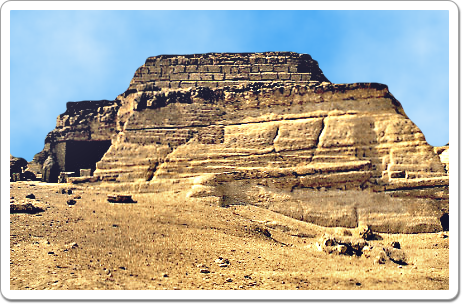A remarkable tomb, once believed to have been the final resting place of the last king of the 4th Dynasty, Shepseskaf, was constructed near the Valley Temple of Mykerinos' funerary complex at Giza.
The 1932/33 excavations at this site revealed, however, that the tomb had been built for a queen named Khentkaus. Although this queen’s titulary, “the Mother of two Kings of Upper and Lower Egypt” was the same as that of a 5th Dynasty queen of the same name, the archeological context of the Giza tomb clearly to the end of the 4th Dynasty, making it clear that there were two queens of the same name, only a few generations apart.

Interactive plan of the tomb of Khentkaus I at Giza. Hover over the map and click or tap the little circles to learn more about this structure.
Source: Lehner, Complete Pyramids, p. 138.
The tomb was cut out into a cube of bedrock that was not removed as the remaining stone around it was quarried for the nearby pyramids. This cube was encased in white limestone with a slope of about 74° and topped with a slightly vaulted structure built in masonry The slope of the lower part of this structure is the same as the layers of some earlier step pyramids.

The oddly shaped tomb of Khentkaus I at Giza.
The tomb's internal structure has been damaged very badly in ancient times. The entrance, located in near the South corner of the substructure's east face, opens onto a sloping passage that least to an antechamber, some magazines and the queen's burial chamber. The burial chamber was lined with granite.
A boat pit, a common feature of royal tombs since the Early Dynastic Period, was found near the Southwest corner of the tomb.
A settlement of houses, mostly dated to the 5th and 6th Dynasties, flanked the causeway that led to the entrance of the tomb. Near the end of the causeway, it turns south, giving the settlement an inverted-L shape. The southern extension consists of some larger and thus somewhate more important houses. This small, but clearly planned settlement was inhabited by people working in the service of the deceased queen’s funerary cult.
Immediately to the southwest of this settlement’s Southern extension, and enclosure and some rooms were found, but wether these were part of a Valley Temple for Khentkaus I’s mortuary complex is very doubtful.
The absence of a Valley Temple might indicate that Khentkaus I shared the Valley Temple of Mykerinos.
Khentkaus I probably was the last member of the royal family of the 4th Dynasty to have been buried at Giza. Shepseskaf, the last king of the dynasty, had already moved back to Saqqara for his funerary monument and the kings of the two next dynasties would prefer either Saqqara or Abusir for their burials.